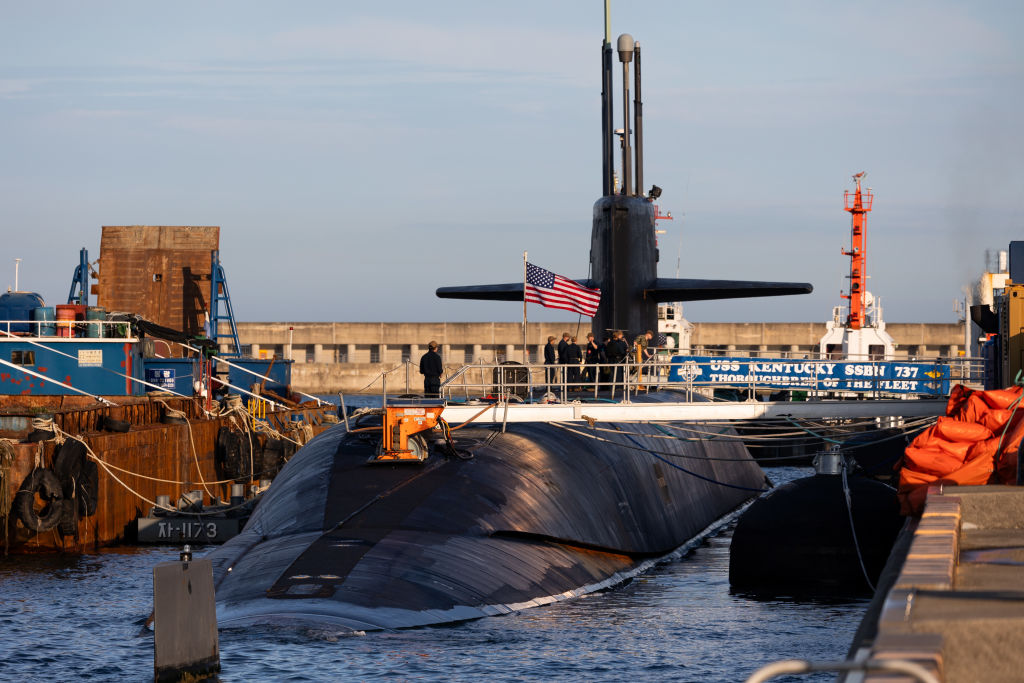
560 feet long, 18,750 tons submerged and carrying as many as 154 Tomahawk cruise missiles, the Ohio-class guided missile submarines are among the U.S. military’s most formidable weapons. Ordinarily, the location of Ohio-class submarines is kept top secret as a number of the nuclear-powered vessels silently patrol the ocean at any given time.
But in a rare public announcement, U.S. Central Command wrote on X, formerly known as Twitter, that an Ohio-class submarine had arrived in the Middle East on Nov. 5. Pentagon officials confirmed to Bloomberg that the the submarine was the USS Florida, which was previously used to fire scores of Tomahawk missiles at Libyan air defense targets in 2011 during a NATO operation that led to the overthrow of Libya's then-leader Muammar Gaddafi.
“It's unusual to highlight the movement of strategic weapon systems like an Ohio-class submarine,” says Jonathan Lord, Director of the Middle East Security program at the Center for a New American Security. “It really speaks to the administration's efforts to keep Hezbollah and other actors from joining this fight and opening new fronts against Israel.”
More From TIME
For some experts, the announcement was a sign that the U.S. government does not think that the specter of a wider conflict has dissipated yet. “You don’t do the types of deployments (and messaging) the administration is doing in the region right now unless you have good reason to worry” about escalation, Eric Brewer, a nuclear weapons policy expert at the Nuclear Threat Initiative wrote on X.
Given the range of the Tomahawk missiles, as well as submarine’s capabilities, Lord says that the deployment is “probably focused more on threats in and around the Mediterranean. That said, those missiles can range much further than northern Lebanon.”
Read More: What to Know About the Attacks on U.S. Military Bases in the Middle East
The Lebanese militant group Hezbollah has repeatedly threatened that it may escalate its attacks on Israel, but in a highly-anticipated speech on Friday the group’s leader Hassan Nasrallah came short of declaring war. So far, the group, which has tens of thousands of fighters and an arsenal of more than 100,000 rockets, has fired rockets and drones at northern Israel, as well as exchanging fire with Israeli forces on the Lebanon-Israel border. From Yemen, Houthi rebels have also fired missiles and drones at Israel.
Other Iran-supported groups in Syria and Iraq have been firing rockets and drones at U.S. military bases in the region. On Monday, Nov. 6, Pentagon spokesperson Pat Ryder said that the number of attacks had risen to 38 attempted attacks since Oct. 17. 46 service members have been wounded in total. While the U.S. has responded with two strikes on Iran-linked military sites in Syria on Oct. 27, this has done little to stymie the attacks so far.
More Must-Reads From TIME
- The 100 Most Influential People of 2024
- Coco Gauff Is Playing for Herself Now
- Scenes From Pro-Palestinian Encampments Across U.S. Universities
- 6 Compliments That Land Every Time
- If You're Dating Right Now , You're Brave: Column
- The AI That Could Heal a Divided Internet
- Fallout Is a Brilliant Model for the Future of Video Game Adaptations
- Want Weekly Recs on What to Watch, Read, and More? Sign Up for Worth Your Time
Contact us at letters@time.com